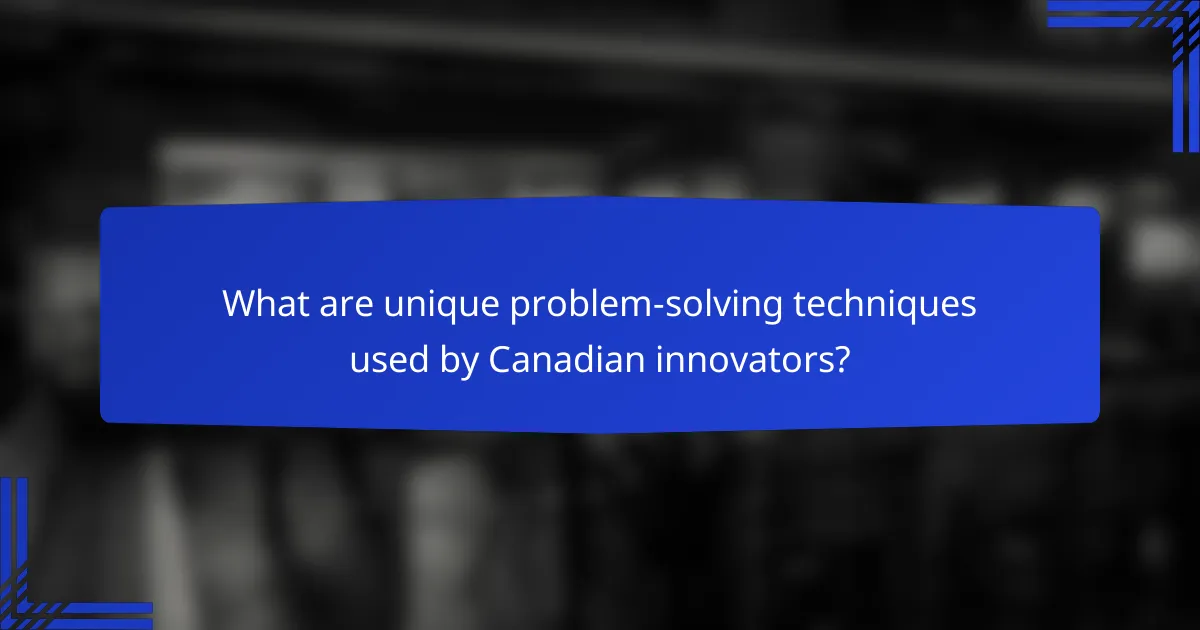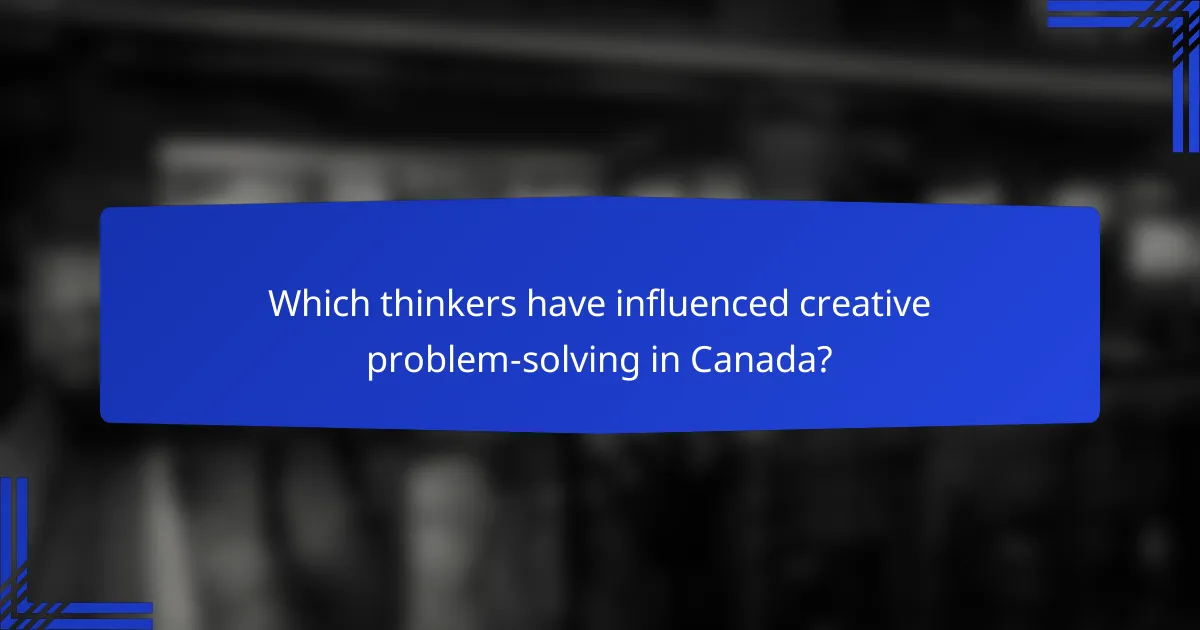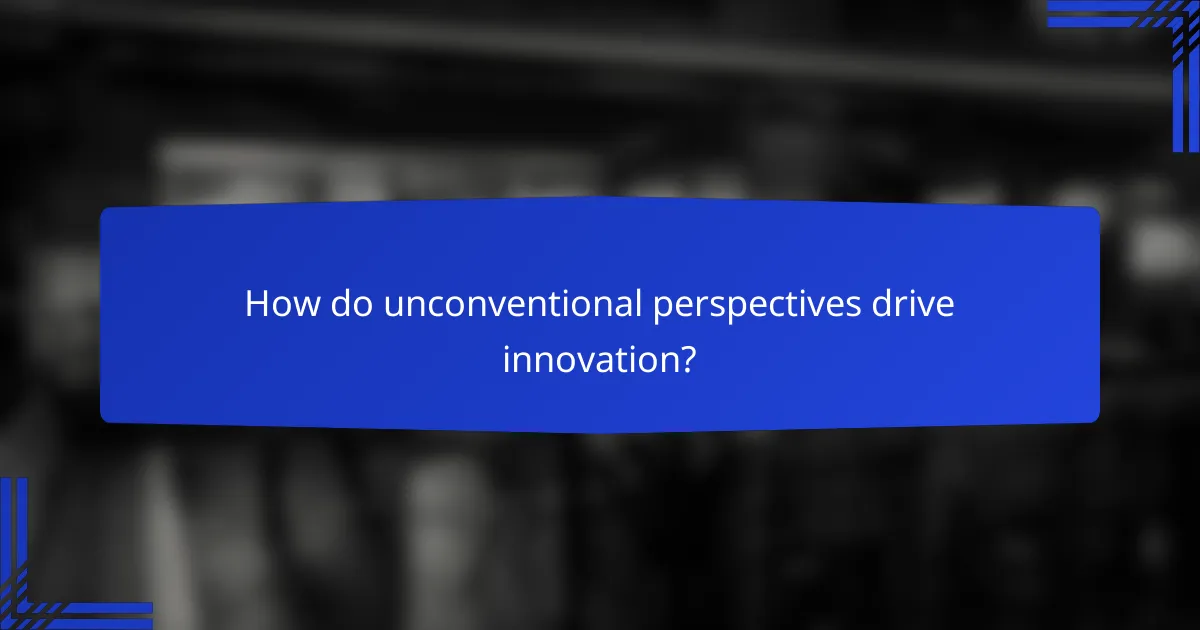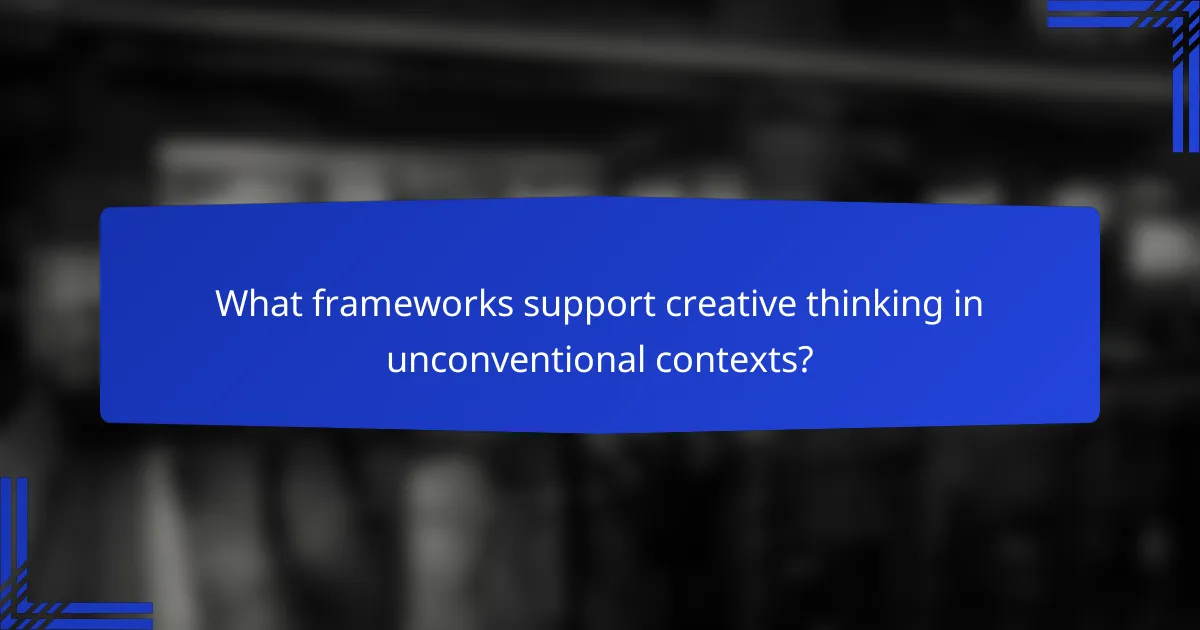Bizarre thinkers challenge conventional wisdom, offering unconventional ideas that inspire creativity and innovative problem-solving. By embracing diverse perspectives, these individuals contribute to a rich tapestry of thought that fosters unique solutions to complex challenges. Their influence spans various fields, showcasing the power of creativity in driving progress and change.

How can unconventional ideas enhance creativity in Toronto?
Unconventional ideas can significantly boost creativity in Toronto by encouraging diverse perspectives and innovative problem-solving approaches. This city, known for its cultural diversity, thrives on unique viewpoints that challenge traditional thinking.
Brainstorming sessions
Brainstorming sessions in Toronto can be enhanced by inviting participants from various backgrounds, fostering an environment where unconventional ideas flourish. Consider using techniques like mind mapping or reverse brainstorming to stimulate creativity. Aim for sessions that last between 30 to 60 minutes to maintain energy and focus.
To maximize effectiveness, establish clear objectives and encourage open-mindedness. Avoid criticism during the idea generation phase to create a safe space for sharing wild concepts.
Collaborative workshops
Collaborative workshops in Toronto can harness the power of unconventional ideas by bringing together individuals from different disciplines. These workshops should focus on problem-solving through creative exercises, such as role-playing or scenario building, which can lead to innovative solutions.
Consider organizing workshops that last a few hours to a full day, allowing ample time for exploration and discussion. Ensure that participants are encouraged to share their unique experiences and insights, which can lead to unexpected breakthroughs.
Artistic expression
Artistic expression serves as a powerful tool for enhancing creativity in Toronto by allowing individuals to explore unconventional ideas through various mediums. Engaging in activities like painting, writing, or performance art can unlock new ways of thinking and problem-solving.
Encourage participation in local art events or community projects that promote creative expression. These activities not only foster individual creativity but also build connections among diverse groups, enriching the overall creative landscape of the city.

What are unique problem-solving techniques used by Canadian innovators?
Canadian innovators often employ unique problem-solving techniques that emphasize creativity and practicality. These methods, such as design thinking, reverse engineering, and mind mapping, enable teams to tackle complex challenges effectively.
Design thinking
Design thinking is a human-centered approach that focuses on understanding the needs of users to develop innovative solutions. It typically involves five stages: empathize, define, ideate, prototype, and test. This iterative process encourages collaboration and creativity, allowing teams to refine ideas based on user feedback.
For instance, a Canadian startup might use design thinking to create a new app by first interviewing potential users to identify their pain points, then brainstorming features, and finally developing a prototype to gather user reactions. This method helps ensure that the final product truly meets user needs.
Reverse engineering
Reverse engineering involves deconstructing existing products or systems to understand their components and functionality. This technique can reveal insights into how to improve a design or create something new based on proven concepts. Canadian innovators often apply this method to analyze competitors’ products and identify gaps in the market.
For example, a company might take apart a popular gadget to learn about its technology and design choices. By understanding what works well and what doesn’t, they can innovate on those ideas, potentially leading to a more effective or user-friendly product.
Mind mapping
Mind mapping is a visual brainstorming technique that helps organize thoughts and ideas around a central concept. This method allows individuals and teams to explore various facets of a problem, making connections between different ideas. Canadian innovators frequently use mind mapping to facilitate group discussions and enhance creativity.
To create a mind map, start with a central idea in the middle of a page, then branch out with related concepts, tasks, or solutions. This visual representation can help teams identify new pathways for innovation and ensure that all perspectives are considered in the problem-solving process.

Which thinkers have influenced creative problem-solving in Canada?
Several influential thinkers in Canada have shaped creative problem-solving through their unconventional ideas and unique perspectives. Their contributions span various fields, offering valuable insights into innovative approaches and solutions.
Marshall McLuhan
Marshall McLuhan, a renowned media theorist, is best known for his concept of “the medium is the message.” He emphasized how communication technologies shape human experiences and societal structures. His ideas encourage creative problem-solving by prompting individuals to consider the implications of the tools they use.
For example, McLuhan’s work can inspire businesses to rethink their marketing strategies by focusing on how the medium influences consumer perception. Understanding the effects of different platforms can lead to more effective outreach and engagement.
Malcolm Gladwell
Malcolm Gladwell, a prominent author and journalist, explores the nuances of human behavior and decision-making. His books, such as “Outliers” and “Blink,” highlight the importance of context and intuition in problem-solving. Gladwell’s insights encourage individuals to look beyond conventional wisdom and consider the underlying factors that drive success.
For instance, his analysis of the “10,000-hour rule” suggests that dedication and practice are crucial for achieving expertise. This perspective can motivate aspiring professionals to focus on skill development as a pathway to innovative solutions.
David Suzuki
David Suzuki, an environmental activist and scientist, advocates for sustainable practices and ecological awareness. His work emphasizes the interconnectedness of human actions and environmental health, pushing for creative solutions to pressing ecological issues. Suzuki’s perspective encourages individuals and organizations to think critically about their environmental impact.
In practical terms, this means adopting sustainable practices in business operations or community initiatives. For example, implementing green technologies or promoting conservation efforts can lead to innovative approaches that benefit both the environment and the economy.

How do unconventional perspectives drive innovation?
Unconventional perspectives drive innovation by challenging existing paradigms and encouraging fresh ideas. These unique viewpoints can lead to creative solutions that traditional thinking might overlook, ultimately fostering a culture of innovation.
Challenging norms
Challenging norms involves questioning established practices and beliefs that may limit creativity. By pushing against the status quo, individuals can uncover new opportunities and insights that can lead to groundbreaking innovations.
For example, companies like Apple and Tesla have thrived by redefining industry standards and consumer expectations. Their willingness to challenge conventional wisdom has allowed them to create products that resonate deeply with users.
Encouraging risk-taking
Encouraging risk-taking is essential for fostering innovation, as it allows individuals to explore untested ideas without the fear of failure. Organizations that promote a culture of experimentation often find that their teams are more willing to pursue bold solutions.
For instance, Google’s “20% time” policy allows employees to dedicate a portion of their workweek to projects they are passionate about, leading to innovative products like Gmail and Google News. This approach demonstrates how calculated risks can yield significant rewards.
Fostering diversity
Fostering diversity in teams brings together varied perspectives, experiences, and skills, which can enhance problem-solving capabilities. Diverse groups are more likely to generate innovative ideas because they approach challenges from multiple angles.
Research has shown that companies with diverse teams often outperform their competitors in terms of creativity and financial performance. Embracing diversity not only enriches the workplace but also leads to more comprehensive and effective solutions.

What frameworks support creative thinking in unconventional contexts?
Frameworks that support creative thinking in unconventional contexts include structured methods that encourage innovative ideas and problem-solving. These frameworks guide individuals and teams in exploring diverse perspectives and generating unique solutions.
SCAMPER technique
SCAMPER is a creative thinking framework that prompts users to explore ideas through seven different lenses: Substitute, Combine, Adapt, Modify, Put to another use, Eliminate, and Reverse. By applying these prompts, individuals can rethink existing products or processes and uncover new possibilities.
For example, if considering a smartphone, one might substitute its battery with a solar-powered option or combine it with a smartwatch for enhanced functionality. This technique is particularly useful in brainstorming sessions, as it encourages participants to think outside traditional boundaries.
Six Thinking Hats
The Six Thinking Hats method, developed by Edward de Bono, provides a structured way to approach problems from multiple perspectives. Each “hat” represents a different mode of thinking: White (facts), Red (feelings), Black (caution), Yellow (benefits), Green (creativity), and Blue (process control).
By wearing different hats during discussions, teams can ensure a balanced exploration of ideas. For instance, while one member focuses on potential risks (Black Hat), another can highlight creative solutions (Green Hat). This approach minimizes conflict and enhances collaboration by clearly defining roles in the thinking process.

How can organizations in Canada implement creative problem-solving strategies?
Organizations in Canada can implement creative problem-solving strategies by fostering an environment that encourages innovation and collaboration. This involves utilizing training programs, establishing innovation labs, and forming cross-disciplinary teams to leverage diverse perspectives and skills.
Training programs
Training programs focused on creative problem-solving can equip employees with essential skills and techniques. Workshops on design thinking, brainstorming methods, and lateral thinking can help participants develop a mindset conducive to innovation. Consider offering these programs regularly to keep skills fresh and encourage ongoing creativity.
Organizations may also partner with local educational institutions to create tailored training sessions. This collaboration can provide access to the latest research and methodologies in creative problem-solving.
Innovation labs
Innovation labs serve as dedicated spaces where teams can experiment with new ideas and solutions. These labs often provide resources such as advanced technology, prototyping tools, and a collaborative atmosphere that stimulates creativity. Organizations should consider setting up these labs to encourage hands-on experimentation and rapid iteration.
To maximize the effectiveness of innovation labs, establish clear goals and metrics for success. This could include the number of prototypes developed or the speed of idea implementation, allowing for measurable outcomes that can guide future efforts.
Cross-disciplinary teams
Cross-disciplinary teams bring together individuals from various backgrounds and expertise, fostering a rich environment for creative problem-solving. By combining different perspectives, these teams can approach challenges from unique angles, leading to innovative solutions. Organizations should aim to create diverse teams that include members from different departments, such as marketing, engineering, and design.
To facilitate collaboration, provide team-building activities and regular brainstorming sessions. This can help break down silos and encourage open communication, ultimately enhancing the team’s ability to generate creative ideas and solutions.
